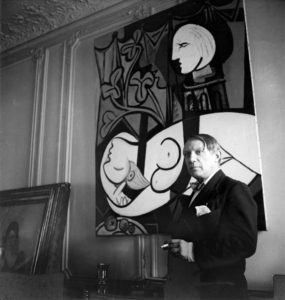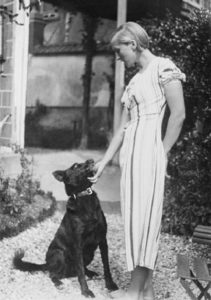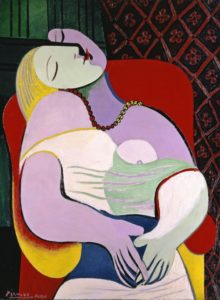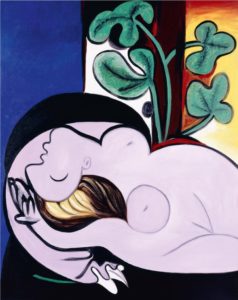 ‘The work that one does is a way of keeping a diary’ is the quote from the artist which begins Tate Modern’s big Summer blockbuster exhibition. This takes the visitor chronologically, month by month, through 1932, an extraordinarily productive artistic year in Picasso’s life. This is a large exhibition, with ten rooms of works, mostly paintings, but some sculpture and drawings. Some of the works have never been shown together before.
‘The work that one does is a way of keeping a diary’ is the quote from the artist which begins Tate Modern’s big Summer blockbuster exhibition. This takes the visitor chronologically, month by month, through 1932, an extraordinarily productive artistic year in Picasso’s life. This is a large exhibition, with ten rooms of works, mostly paintings, but some sculpture and drawings. Some of the works have never been shown together before.
At the beginning of 1932 Picasso was happily settled, at least outwardly, in a fashionable Parisian apartment with his wife, the Russian ballerina Olga Khokhlova, and son, Paulo ( see Cecil Beaton’s photograph of him, right). His painting La Coiffure (1905) sold for a record amount and he was offered a major retrospective at the Galeries George Petit, something then very unusual for a living artist (though his rival Henri Matisse had one at the same gallery in 1931). He was critically  acclaimed and wealthy, the owner of a beautiful, if decrepit, Normandy château and with a 22-year-old mistress in Marie-Thérèse Walter (he was then aged 50).
acclaimed and wealthy, the owner of a beautiful, if decrepit, Normandy château and with a 22-year-old mistress in Marie-Thérèse Walter (he was then aged 50).
Many of the paintings in this exhibition are of Walter, although Picasso rarely, if ever, painted from life. Her distinctive profile, ‘bow’ lips and blonde hair feature in works created across the year. Sometimes these are almost indescribably tender, her face drawn in soft lines, eyes closed in sleep. In La Reve – The Dream – her look, for this observer, was of post-coital contentment, the artist leaving us in no doubt that sex was involved, witness the membrum virile masquerading as one part of her face.
Olga features too, in a formal portrait which hung, in the retrospective, between two of Paulo and with (exquisite) paintings  from Picasso’s blue period. She also appears, we are told, in a small painting Woman with Dagger showing a woman killing her sexual rival. It was only later, in 1935, when Marie-Thérèse became pregnant by Picasso that Olga moved out, to the south of France. Picasso described this as one of the worst periods of his life, though he wasn’t prepared to divorce, it is suggested, because the law of the time would have resulted in an equal division of all property between husband and wife. Towards the end of the exhibition there are works which reference Walter, of extreme sexual violence. One of these, The Rape, packs a mighty powerful punch.
from Picasso’s blue period. She also appears, we are told, in a small painting Woman with Dagger showing a woman killing her sexual rival. It was only later, in 1935, when Marie-Thérèse became pregnant by Picasso that Olga moved out, to the south of France. Picasso described this as one of the worst periods of his life, though he wasn’t prepared to divorce, it is suggested, because the law of the time would have resulted in an equal division of all property between husband and wife. Towards the end of the exhibition there are works which reference Walter, of extreme sexual violence. One of these, The Rape, packs a mighty powerful punch.
As that opening quote suggests, this exhibition concentrates on the links between the painter’s art and his emotional and sexual life, though there are references to cubism and Picasso’s ‘rivalry’ with Matisse. Given the subject matter of the paintings and sculptures, the personal is bound to predominate. But there is an attempt to put it all into historical context, with many of Picasso’s buyers losing fortunes in the crash to come and fascism in various forms on the rise in Europe. The tragedy of the exhibition title is one foretold.
The exhibition gives the visitor an insight into Picasso’s working methods. The tradition of grand western art (before  Impressionism) suggest that an artist sketches, draws or makes a maquette, than produces, after several attempts, a finished work. It is clear from these paintings and the timeline attached to them that this isn’t necessarily how Picasso worked. Room 1 has two very similar works. The earlier is polished, the later less ‘finished’. It is the later work which is the more powerful. In addition, works produced later in the year look like sketches, but are finished pictures.
Impressionism) suggest that an artist sketches, draws or makes a maquette, than produces, after several attempts, a finished work. It is clear from these paintings and the timeline attached to them that this isn’t necessarily how Picasso worked. Room 1 has two very similar works. The earlier is polished, the later less ‘finished’. It is the later work which is the more powerful. In addition, works produced later in the year look like sketches, but are finished pictures.
There is also variation in style, from the fine, elaborate line of The Sculptor or Woman in a Red Armchair to blocks of flat, intense colour. He uses different colour, or dots of colour, to suggest depth or shape. I liked very much the highly patterned surfaces of Girl Before a Mirror. Sometimes the paint is applied in thick impasto, with, it appears, a knife or flat object, sometimes it is even, sometimes ‘drawn’.
I shall return to this exhibition, there is so much that I want to see again. It is very well worth a visit, ( but wear comfortable shoes ). The EY Exhibition: Picasso 1932, Love, Fame, Tragedy runs until 9th September at Tate Modern. Tickets cost £25 (inclu. donation)/£20 concessions.
If you enjoyed reading this article why not try Paul Nash Georgia O’Keeffe Royal Art Rhythm & Reaction Impressionists in London


 RSS – Posts
RSS – Posts